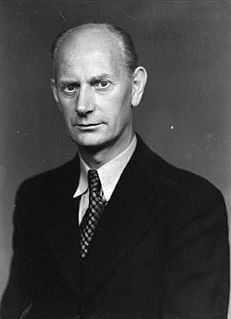
Einar Henry Gerhardsen was a Norwegian politician from the Labour Party of Norway. He was the 22nd prime minister of Norway for three periods, 1945–1951, 1955–1963 and 1963–1965. With totally 17 years in office, he is the longest serving Prime Minister in Norway since the introduction of parliamentarism. Many Norwegians often refer to him as "Landsfaderen" ; he is generally considered one of the main architects of the post-war rebuilding of Norway after World War II. He also served as the second President of the Nordic Council in 1954.

Trygve Martin Bratteli (help·info) was a Norwegian newspaper editor and politician with the Norwegian Labour Party. He served as the 26th prime minister of Norway from 1971 to 1972 and again from 1973 to 1976. He was president of the Nordic Council in 1978.

Lars Korvald (help·info) was a Norwegian educator and school headmaster. He became associated with the Christian Democratic Party and was elected to the Norwegian Parliament. He served as the 27th prime minister of Norway from 1972 to 1973, leading the cabinet that took over when Trygve Bratteli resigned in the wake of the first referendum over Norway's membership in the European Economic Community.
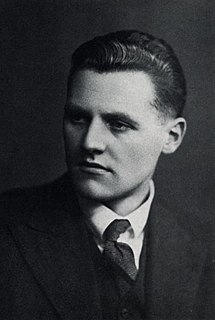
John Daniel Lyng (help·info) was a Norwegian politician from the Conservative Party. He was the 24th prime minister of Norway from 28 August to 25 September 1963 in a coalition government consisting of the Conservative, Centre, Christian Democratic, and Liberal parties. It was the first government in 28 years that was not headed by the Labour Party.

The Labour Party, formerly The Norwegian Labour Party, is a social-democratic political party in Norway. It is positioned on the centre-left of the political spectrum, and is led by Jonas Gahr Støre. It was the senior partner of the governing red–green coalition from 2005 to 2013, and its former leader Jens Stoltenberg served as the prime minister of Norway.

The Workers' Youth League is Norway's largest political youth organization and is affiliated with the Norwegian Labour Party.
The Conservative Party or The Right is a liberal-conservative political party in Norway. It is the major party of the Norwegian centre-right, and was the leading party in government as part of the Solberg cabinet from 2013 to 2021. The current party leader is former Prime Minister Erna Solberg. The party is a member of the International Democrat Union and an associate member of the European People's Party.
The Socialist People's Party was a splinter group of the Norwegian Labour Party (DNA) founded in 1961. SF was principally dissatisfied with the pro-NATO/European Economic Community external policies of DNA. A group centered on the magazine Orientering had been expelled from DNA. The party merged into the Socialist Left Party in 1976.
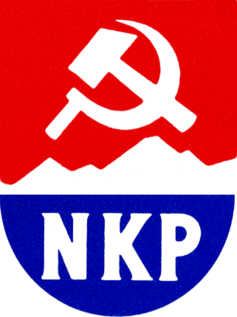
The Communist Party of Norway is a communist party in Norway.
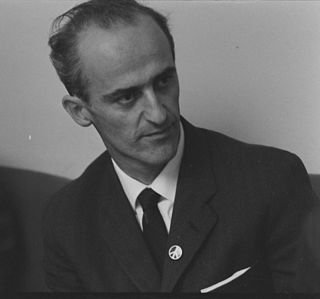
Finn Gustavsen was a Norwegian socialist politician active from 1945 to the late 1970s. He was noted for his uncompromising style and willingness to take contrarian stands.
Kaare Fostervoll was a Norwegian educator and politician for the Labour Party. From 1949 to 1962 he was the director-general of the Norwegian Broadcasting Corporation (NRK).
Jens Haugland was a Norwegian jurist and politician for the Labour Party.
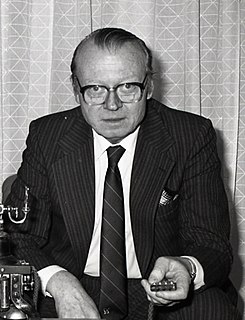
Kjell Torbjørn Holler was a Norwegian economist and politician with the Norwegian Labour Party.

Håkon Olai Kyllingmark was a Norwegian military officer and businessman. He served as a politician for the Conservative Party and was elected to the Norwegian Parliament.

Kings Bay AS is a government enterprise owned by the Norwegian Ministry of Trade and Industry that operates the entire settlement of Ny-Ålesund on Svalbard. The settlement, the most northerly civilian settlement in the world, serves research staff. The company provides the necessary infrastructure, such as transport, real estate, power and water supply, catering and other facilities. The company is also responsible for administering Bjørnøen AS, a government enterprise that owns the entire island of Bjørnøya. In the summer the company also handles cruise ships that arrive at Ny-Ålesund.
Events in the year 1963 in Norway.

The Lyng Cabinet governed Norway between 28 August 1963 and 25 September 1963. It was the first in 28 years not to be led by the Norwegian Labour Party. It was a centre-right coalition government of the Conservative Party, Centre Party, Christian Democratic Party and Liberal Party led by John Lyng of the Conservative Party. It had fifteen members, of which five were from the Conservative Party, four were from the Centre Party, three were from the Christian Democratic Party and three were from the Liberal Party. Karen Grønn-Hagen was the cabinet's only female member.
In Norway, a state secretary is a partisan political position within the executive branch of government. Contrary to the position secretary of state in many other countries, a Norwegian state secretary does not head his or her ministry, rather, they are second in rank to a minister. Resembling a de facto vice minister, the state secretary, however, cannot attend a Council of State, and does not act as a temporary minister in case of illness or other leave of absence.












